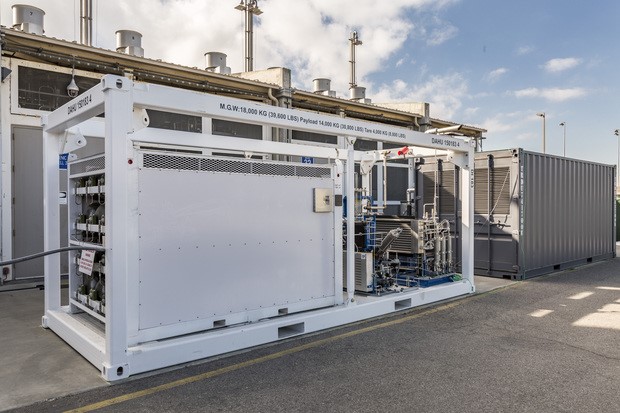Boeing has announced that after 16 months of development, it has delivered a fuel cell energy storage system to the U.S. Navy for testing. The cell will be tested to determine its ability to support the energy needs of military and commercial customers.
The system introduces the use of a technology called a “reversible solid oxide fuel cell” to store energy from renewable resources (including wind and solar), producing clean, zero-emissions electricity.
The Solid Oxide Fuel Cell (SOFC) system, the largest of its type, can generate 50 kilowatts (KW) of power and store up to 600KW. It generates, compresses and stores hydrogen. When the grid demands power, it operates as a fuel cell, consuming the stored hydrogen to produce electricity. Boeing’s technology is unique in being able to both store energy and produce electricity in a single system, making the technology “reversible.”
The system uses a fuel cell stack technology manufactured by Sunfire, a Boeing supplier based in Dresden, Germany.
SOLID OXIDE FUEL CELL BACKGROUND
Solid oxide fuel cells offer design, manufacturing and operational advantages over conventional liquid electrolyte fuel cells,
according to BCC Research analyst Donald Saxman. They are relatively inexpensive, can use a wide variety of fuels and offer a long service life.
“Among the most efficient and cost-effective sources of power, SOFC’s can provide a cost-effective and performance-driven rival for other fuel cells, batteries, internal combustion engines and coal- or oil-fired heat engines,” he says.
Like batteries, fuel cells produce electrical energy through an electrochemical process. Unlike batteries, fuel cells are conversion devices that change chemical fuel into electricity. Like combustion engines, fuel cells convert fuel into energy, but in this case, the energy is electricity rather than kinetic (movement) or heat.
Saxman states that “as a rule,” fuel cells tend to cost more than equivalent energy density batteries, and cost much more than equivalent engines. However, they often have a much longer service life. Electrical storage batteries, by definition, store electric power. Conceptually, this power can be considered as fuel. Fuel cells cannot directly store electrical energy. Instead they consume many types of fuels and generate electricity.
Fuel cell sizes range from tiny portable units that can be held in the hand to massive stacks the size of a building. Fuel cells can be combined into stacks with effectively unlimited size. Most commercial SOFC’s are relatively large, but smaller portable designs are available and are the subject of intense research.
FUEL CELL SOLUTION OFFERS NEW TECHNOLOGY FOR NAVY
Boeing’s first unit was commissioned on the Southern California Edison power grid at the company’s Huntington Beach, Calif., facility before being installed for further testing on the Navy’s ‘microgrid’ at the Naval Facilities Engineering Command, Engineering and Expeditionary Warfare Center in Port Hueneme, Calif.
The fuel cell product was developed using the company’s experience with energy systems for unmanned undersea vehicles and can be adapted and customized for a variety of defense and commercial applications.
Boeing researcher Joshua Mermelstein says, “Boeing has been active in the development of a fully integrated, grid-tied RSOFC system for military forward operating base micro-grids and commercial utility energy storage. Utility grid operators are being faced with the challenges of intermittence and variability in energy production from such renewables.”
He adds that as a result, “utility operators must reduce their primary load generation to offset the incoming renewable energy. In cases in which renewable generation is high and consumption is low, the primary power generators must be reduced to their minimum operating load and excess renewable energy must be curtailed if energy storage is not available.”
MICRO-GRIDS AS LARGER-SCALE POWER SOURCES FOR NAVY
According to
Lucas Mearian, microgrids are small-scale power infrastructures that operate autonomous from the centralized grid run by utilities. He notes that “according to a 2015 microgrid study by GTM Research, the military made up 35% of U.S. operational microgrid capacity.”
Mearian relates that Omar Saadeh, a senior grid analyst at GTM Research, says that while “solar power is often promoted as the resource of the future, natural gas-fired generation accounts for 67% of the military’s domestic microgrid energy generation.”
“This is due to its rapid dispatchability and reliability as a larger-scale power source," Saadeh tells Mearian. "That being said, remote bases, which are smaller by nature, are deploying renewable and storage combinations as economically viable solutions that to meet today’s energy needs."
BCC Research analyst Saxman anticipates the global market for SOFC’s to reach nearly$1.2 billion by 2020 from $662 billion in 2015, increasing at a five-year compound annual growth rate (CAGR) of 12.3%.




